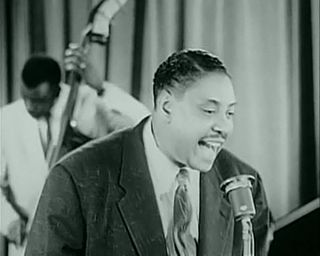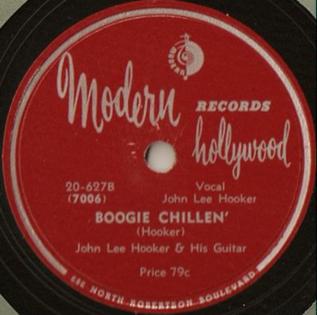Related Research Articles

Blues is a music genre and musical form that originated amongst African-Americans in the Deep South of the United States around the 1860s. Blues incorporated spirituals, work songs, field hollers, shouts, chants, and rhymed simple narrative ballads from the African-American culture. The blues form is ubiquitous in jazz, rhythm and blues, and rock and roll, and is characterized by the call-and-response pattern, the blues scale, and specific chord progressions, of which the twelve-bar blues is the most common. Blue notes, usually thirds, fifths or sevenths flattened in pitch, are also an essential part of the sound. Blues shuffles or walking bass reinforce the trance-like rhythm and form a repetitive effect known as the groove.

John Lee Hooker was an American blues singer, songwriter, and guitarist. The son of a sharecropper, he rose to prominence performing an electric guitar-style adaptation of Delta blues that he developed in Detroit. Hooker often incorporated other elements, including talking blues and early North Mississippi hill country blues. He developed his own driving-rhythm boogie style, distinct from the 1930s–1940s piano-derived boogie-woogie. Hooker was ranked 35 in Rolling Stone's 2015 list of 100 greatest guitarists, and has been cited as one of the greatest male blues vocalists of all time.
Rock and roll is a genre of popular music that evolved in the United States during the late 1940s and early 1950s. It originated from African American music such as jazz, rhythm and blues, boogie-woogie, electric blues, gospel, and jump blues, as well as country music. While rock and roll's formative elements can be heard in blues records from the 1920s and in country records of the 1930s, the genre did not acquire its name until 1954.

Rhythm and blues, frequently abbreviated as R&B or R'n'B, is an African-American genre of popular music that originated within African-American communities in the 1940s. The term was originally used by record companies to describe recordings marketed predominantly to African Americans, at a time when "rocking, jazz based music ... [with a] heavy, insistent beat" was becoming more popular. In the commercial rhythm and blues music typical of the 1950s through the 1970s, the bands usually consisted of a piano, one or two guitars, bass, drums, one or more saxophones, and sometimes background vocalists. R&B lyrical themes often encapsulate the African-American history and experience of pain and the quest for freedom and joy, as well as triumphs and failures in terms of societal racism, oppression, relationships, economics, and aspirations.
Jump blues is an up-tempo style of blues, jazz, and boogie woogie usually played by small groups and featuring horn instruments. It was popular in the 1940s and was a precursor of rhythm and blues and rock and roll. Appreciation of jump blues was renewed in the 1990s as part of the swing revival.
Electric blues is blues music distinguished by the use of electric amplification for musical instruments. The guitar was the first instrument to be popularly amplified and used by early pioneers T-Bone Walker in the late 1930s and John Lee Hooker and Muddy Waters in the 1940s. Their styles developed into West Coast blues, Detroit blues, and post-World War II Chicago blues, which differed from earlier, predominantly acoustic-style blues. By the early 1950s, Little Walter was a featured soloist on blues harmonica using a small hand-held microphone fed into a guitar amplifier. Although it took a little longer, the electric bass guitar gradually replaced the stand-up bass by the early 1960s. Electric organs and especially keyboards later became widely used in electric blues.
A riff is either a repeated chord progression or a refrain in music ; it is a pattern, or melody, often played by the rhythm section instruments or a solo instrument, that forms the basis or accompaniment of a musical composition. Though riffs are most often found in rock music, heavy metal music, Latin, funk, and jazz, classical music is also sometimes based on a riff, such as Ravel's Boléro. Riffs can be as simple as a tenor saxophone honking a simple, catchy rhythmic figure, or as complex as the riff-based variations in the head arrangements played by the Count Basie Orchestra.

Albert Clifton Ammons was an American pianist and player of boogie-woogie, a blues style popular from the late 1930s to the mid-1940s.
Blues rock is a fusion genre and form of rock music that relies on the chords/scales and instrumental improvisation of blues. It is mostly an electric ensemble-style music with instrumentation similar to electric blues and rock. From its beginnings in the early to mid-1960s, blues rock has gone through several stylistic shifts and along the way it inspired and influenced hard rock, Southern rock, and early heavy metal.
The origins of rock and roll are complex. Rock and roll emerged as a defined musical style in the United States in the early to mid-1950s. It derived most directly from the rhythm and blues music of the 1940s, which itself developed from earlier blues, the beat-heavy jump blues, boogie woogie, up-tempo jazz, and swing music. It was also influenced by gospel, country and western, and traditional folk music. Rock and roll in turn provided the main basis for the music that, since the mid-1960s, has been generally known simply as rock music.
Boogie is a repetitive, swung note or shuffle rhythm, "groove" or pattern used in blues which was originally played on the piano in boogie-woogie music. The characteristic rhythm and feel of the boogie was then adapted to guitar, double bass, and other instruments. The earliest recorded boogie-woogie song was in 1916. By the 1930s, Swing bands such as Benny Goodman, Glenn Miller, Tommy Dorsey and Louis Jordan all had boogie hits. By the 1950s, boogie became incorporated into the emerging rockabilly and rock and roll styles. In the late 1980s and the early 1990s country bands released country boogies. Today, the term "boogie" usually refers to dancing to pop, disco, or rock music.

"Boogie Chillen'" or "Boogie Chillun" is a blues song first recorded by John Lee Hooker in 1948. It is a solo performance featuring Hooker's vocal, electric guitar, and rhythmic foot stomps. The lyrics are partly autobiographical and alternate between spoken and sung verses. The song was his debut record release and in 1949, it became the first "down-home" electric blues song to reach number one in the R&B records chart.

"On the Road Again" is a song recorded by the American blues rock group Canned Heat in 1967. A driving blues rock boogie, it was adapted from earlier blues songs and includes mid-1960s psychedelic rock elements. Unlike most of Canned Heat's songs from the period which were sung by Bob Hite, second guitarist and harmonica player Alan Wilson provides the distinctive high pitched vocal, sometimes described as a falsetto.

"Train Kept A-Rollin'" is a song first recorded by American jazz and rhythm and blues musician Tiny Bradshaw in 1951. Originally performed in the style of a jump blues, Bradshaw borrowed lyrics from an earlier song and set them to an upbeat shuffle arrangement that inspired other musicians to perform and record it. Johnny Burnette and the Rock and Roll Trio made an important contribution in 1956 – they reworked it as a guitar riff-driven song, which features an early use of intentionally distorted guitar in rock music.

Goree Chester Carter or Christer Carter, was an American singer, guitarist, drummer, and songwriter. He was also credited with the stage names Little T-Bone, Rocky Thompson and Gory Carter, and recorded music in blues genres such as electric blues, jump blues and Texas blues, as well as rock and roll.

"Roll 'Em Pete" is a boogie-woogie song, originally recorded in December 1938 by Big Joe Turner and pianist Pete Johnson. The recording is regarded as one of the most important precursors of what later became known as rock and roll.

"One Bourbon, One Scotch, One Beer" is a blues song written by Rudy Toombs and recorded by Amos Milburn in 1953. It is one of several drinking songs recorded by Milburn in the early 1950s that placed in the top ten of the Billboard R&B chart. Other artists released popular recordings of the song, including John Lee Hooker in 1966 and George Thorogood in 1977.

"Guitar Boogie" is a guitar instrumental recorded by Arthur "Guitar Boogie" Smith in 1945. It was one of the first recordings in the style later dubbed "hillbilly boogie" to reach a widespread audience, and eventually sold nearly three million copies. It was the first guitar instrumental to climb the country music charts, and then crossover and also gain high rankings on the popular music charts. "Guitar Boogie" has been interpreted and recorded by a variety of musicians. It is among the songs discussed as the first rock and roll record.
Aaron "Pinetop" Sparks was an American blues pianist active in St. Louis in the early 1930s. He died in his twenties from either poisoning or exhaustion.

"Crazy About My Baby" is a boogie woogie song, first recorded by Blind Roosevelt Graves in 1929. It was perhaps the first recorded to contain all elements of what would come to be called rock and roll, and has been described as the first song of that genre.
References
- 1 2 3 4 Erlewine, Bogdanov & Woodstra 2001, p. 2.
- 1 2 3 4 5 6 7 8 Cope 2019, eBook.
- ↑ Palmer 1982, p. 244.
- ↑ Bennett 2020, pp. 37–38.
- ↑ Palmer 1982, pp. 243–244.
- ↑ Palmer 1982, p. 243.
- 1 2 Koda, Cub. "John Lee Hooker: Boogie Chillen' – Review". AllMusic . Retrieved December 12, 2020.
- ↑ Johnson 2014, eBook.
- ↑ Rubin 2015, eBook.
- ↑ Birnbaum 2012, p. 13.
- ↑ Popoff 2004, p. 150.